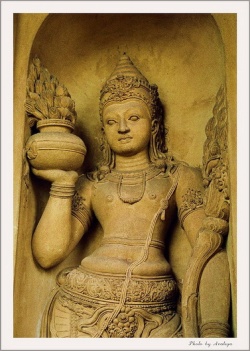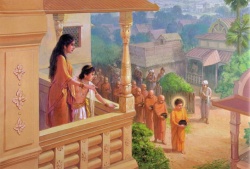Three Pure Land Sutras
Pure Land Buddhism is based on three basic sutras:
- 1. Amitabha Sutra (or Shorter Amitabha Sutra, or Smaller Sukhavati-Vyuha, or the Sutra of Amida)
- 2. Longer Amitabha Sutra (or Longer Sukhavati-Vyuha, or the Teaching of Infinite Life)
- 3. Meditation Sutra (or the Meditation on the Buddha of Infinite Life, or the Amitayus Dhyana Sutra).
Sometimes the last chapter of the Avatamsaka Sutra ("The Practices and Vows of the Bodhisattva Samantabhadra") is considered the fourth basic sutra of the Pure Land tradition.
Note: in Pure Land, the Longer Amitabha Sutra is considered a shorter form of the Lotus Sutra.
by Shi Huimin Bio Pure Land Buddhism is based on three basic sutras:
a) Amitabha Sutra (or Shorter Amitabha Sutra, or Smaller Sukhavati-Vyuha, or the Sutra of Amida);
b) Longer Amitabha Sutra (or Longer Sukhavati-Vyuha, or the Teaching of Infinite Life);
c) Meditation Sutra (or the Meditation on the Buddha of Infinite Life, or the Amitayus Dhyana Sutra).
Sometimes the last chapter of the Avatamsaka Sutra ("The Practices and Vows of the Bodhisattva Samantabhadra") is considered the fourth basic sutra of the Pure Land tradition.
Note: in Pure Land, the Longer Amitabha Sutra is considered a shorter form of the Lotus Sutra.
The set of three Chinese Buddhist scriptures comprised of
the Immeasurable Life Sutra (無量壽經, Sukhavativyuha sutra),
On the Immeasurable Life Buddha Sutra (觀無量壽佛經, Guan wuliangshou fo jing), and
the Amitabha sutra (阿彌陀經, Smaller sukhavati-vyuha).
Chinese Pure Land Buddhism (淨土宗) uses the recitation of the name of The Buddha as its main Form of Ritual practice.
The Three Pure land Sutras, the Power of the original vow of Amitabha, salvation and Rebirth in the utmost Joy of the Pure land of the West.
The original Sanskrit definition of “Pure land” is “Buddha-kshetra” (or Buddhist state), which is a contrast to the Suffering of everyday reality and which expresses the yearnings toward the ideal World that was taught by The Buddha.
From the initiation of the Pure Buddhist land by the various Buddhas, achieving the pledges of Sentient beings, practicing the Bodhisattva Path, and accumulating merits, the honored, clear and pure realm is established.
There are twelve Chinese translations of the Immeasurable Life Sutra, and one of the more popular translations was composed by the Sogdian Monk Samghavarman (康僧鎧) in the Cao Wei (曹魏) Dynasty of the Three Kingdoms period (三國).
The contents of this scripture describe the age of the Lokeshvara-raja Buddha,
in which a king leaves his home to become a Monk and is given the name Dharmakara (Dharma-storehouse).
He pledges to save all Sentient beings and send them to the realm of utmost Joy.
Dharmakara makes 48 vows (四十八願) to achieve this realm of utmost Joy, such as vow #18:
“Sentient beings in all ten directions believing and rejoicing with the utmost Mind desiring to create my kingdom to the tenth recitation; if it is not created / the true Awakening will not be taken.
Only to eliminate the five unpardonable sins / and the slandering of the true Dharma.”
Dharmakara would later become The Buddha named “Immeasurable Life.”
His kingdom is in the west, and it is named “Peace and Happiness.”
The scripture goes on to describe how the realm of utmost Joy relies on proper adornments and other issues.
The final discussion in the scripture is on conditions and methods for each of the three levels of upper, middle, and lower rebirths.
Some Taiwanese Pure land Buddhist groups emphasize the merits of reciting this scripture, and how recitation should be a daily Form of practice.
On the Immeasurable Life Buddha Sutra was translated in the kingdom of Liu Song (劉宋) during the Northern and Southern Dynasties (南北朝) by Kalayashas (彊良耶舍).
The Tang (唐) Dynasty Monk Shandao (善導) composed a four-fascicle Commentary on the Immeasurable Life Sutra, which was very influential to later generations.
The content of the scripture uses the 16 Meditations sequence to describe how to contemplate the physical characteristics of Amitabha Bodhisattva, Avalokiteshvara Bodhisattva,
and Mah?sth?mapr?pta Bodhisattva, as well as how to make vows to donate one’s merits so that one may be reborn in the western realm of utmost Joy.
The 14th, 15th, and 16th Meditations explain the three levels of Rebirth and the circumstances of guidance under a Bodhisattva.
Each level of Rebirth is subdivided into three lives, for a total of nine levels, which is the basis of the common expression “nine levels of Rebirth.”
This scripture is also the primary basis for “Pure land Transformation Tableaus,” which have also influenced the imagery of Taiwanese Buddhist Art.
The Amitabha Sutra was translated in the Later Qin (後秦) Dynasty by Kumarajiva (鳩摩羅什) as The Spoken Word of The Buddha Amitabha Sutra and by the Tang Dynasty Monk Xuanzang (玄奘) as Praising the Pure land and The Buddha’s Reception Sutra (稱讚淨土佛攝受經).
This scripture emphasizes that “if good sons and good daughters hear and speak of Amitabha, upholding the name, if for one day... if for seven days, single-mindedly without diverting, then when this person faces Death and the end time, Amitabha and the various sages will appear before this person.
At the this person’s end time, the Mind will not be upset, and the person will be reborn in Amitabha’s land of utmost Joy.”
Because of this teaching, practitioners of Pure Land Buddhism often gather together mainly to recite the name of Amitabha.
Otherwise, they meet every seven days, or at other scheduled times, as there is a proven efficacy from meeting at regular intervals, a practice known as “Buddha-seven (佛七).”
The degree of variance from “Buddha-one” to “Buddha-seven,” can be interpreted as a response to the busyness of modern, commerce-driven society.
Chinese Keyword
《無量壽經》 , 《觀無量壽佛經》 , 《阿彌陀經》 , 四十八願 , 十六觀
English Keyword
Larger sukhāvatī-vyūha , Guan wuliangshou fo jing , Smaller sukhāvatī-vyūha , forty-eight vows , sixteen kinds of contemplation , Guan Wuliangshou Fojing
References
<poem>
Cai, Niansheng (Yunchen). (Ed.). (1999). Lu xue yao lue [律學要略]. In Hong Yi da shi fa ji [弘一大師法集]. Taipei: Zheng wen.
Cai, Niansheng (Yunchen). (Ed.). (1999). Nan shan lu xue cheng [南山律學程]. In Hong Yi da shi fa ji [弘一大師法集]. Taipei: Zheng wen.
Hong Yi Da Shi (1995). Nan shan lü zai jia bei lan lüe bian [南山律在家備覽略編]. Taichung: Yang zheng tang.
Shi, Zhi-yu. (Ed.). (1996). Nan shan lü xue ci dian [南山律學辭典]. Taipei: Seeland Monastery.
Southern Mountain Vinaya E-book. Retrieved May 20, 2009. from http://jzf.cixin.org/www.donglin.org/Get/jtxz/20061126898.htm
Chinese Buddhist Electronic Text Association. Retrieved May 20, 2009. from http://www.cbeta.org/cd/index.htm
Extended Reading
Chi, Chiehteng. (2005). Jing tu san jing si xiang yan jiu. [淨土三經思想研究] (=The studies of the three Sutras of the pure-land Buddhism.). MA thesis. Chinese Literature Department, Providence Univ.
Liao, Yuepeng. (1989). Jing tu san xi zhi yan jiu [淨土三系之研究]. Fo guang wen xuan cong shu, No. 5510. Kaohsiung: Fo Guang Shan.

